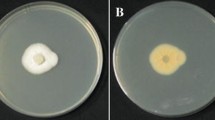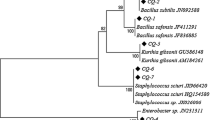Abstract
Production of red pigments (naphthoquinones) by the insect pathogenic fungus Cordyceps unilateralis BCC 1869 was investigated in this study. Cultivation conditions, including temperature, intitial pH of medium, and aeration, were optimised to improve the yield of total naphthoquinones in shake-flask culture of C. unilateralis. The highest yield of total naphthoquinones (3 g L−1) was obtained from a 28-day culture grown in potato dextrose broth with an initial pH of 7.0, at 28°C with shaking-induced aeration at 200 rpm. An extraction process for isolation of the targeted naphthoquinone, 3,5,8-trihydroxy-6-methoxy-2-(5-oxohexa-1,3-dienyl)-1,4-naphthoquinone (3,5,8-TMON), from a culture of C. unilateralis, was also developed. The yield of 3,5,8-TMON obtained was about 1.2 g L−1 or 40% of total naphthoquinones. The stability of 3,5,8-TMON was very high, even upon exposure to strong sunlight (70,000 lx), high temperature up to 200°C, and acid and alkali solutions at concentrations of 0.1 M






Similar content being viewed by others
References
Bhosale P, Gadre RV (2002) Manipulation of temperature and illumination conditions for enhanced beta-carotene production by mutant 32 of Rhodotorula glutinis. Lett Appl Microbiol 34:349–353
Carels M, Shepherd D (1978) The effect of pH and amino acids on conidiation and pigment production of Monascus major ATCC 16362 and Monascus rubiginosus ATCC 16367 in submerged shaken culture. Can J Microbiol 24:1346–1357
Cho YJ, Park JP, Hwang HJ, Kim SW, Choi JW, Yun JW (2002) Production of red pigment by submerged culture of Paecilomyces sinclairii. Lett Appl Microbiol 35:195–202
Cross BE, Edinberry MN (1972) Pigments of Gnomonia erythrostoma. Part I. The structures of erythrostominone, deoxyerythrostominone, and deoxyerythrostominol. J Chem Soc Perkin I 3:380–390
Cross BE, Zammitt LJ (1973) Pigments of Gnomonia erythrostoma. Part II. Epierythrostominol and epideoxyerythrostominol. J Chem Soc Perkin I 23:2975–2976
Demain AL (1996) Fungal secondary metabolism: regulation and functions. In: Sutton BC (ed) A century of mycology. Cambridge University Press, Cambridge, pp 233–254
Dziezak JD (1987) Applications of food colorants. Food Technol 41:78–80
Gustafsson M (1965) On species of the genus Entomophthora Fres. in Sweden. II. Cultivation and physiology. Lantbruk Ann 31:405–457
Hajjaj H, Blanc PJ, Groussac E, Goma G, Uribelarrea JL, Loubiere P (1999) Improvement of red pigment/citrinin production ratio as a function of environmental conditions by Monascus ruber. Biotechnol Bioeng 20:497–501
Kim CH, Kim SW, Hong SI (1998) Production of red pigment by Serratia sp. KH-95 and its cultural properties. Korean J Biotechnol Bioeng 13:431–437
Kim CH, Kim SW, Hong SI (1999) An integrated fermentation separation process for the production of red pigment by Serratia sp. KH-95. Process Biochem 35:485–490
Kittakoop P, Punya J, Kongsaeree P, Lertwerawat Y, Jintasirikul A, Tanticharoen M, Thebtaranonth Y (1999) Bioactive naphthoquinones from Cordyceps unilateralis. Phytochemistry 52:453–457
Kourounakis AP, Assimopoulou AN, Papageorgiou VP, Gavalas A, Kourounakis PN (2002) Alkannin and shikonin: effect on free radical processes and on inflammation-a preliminary pharmacochemical investigation. Arch Pharm (Weinheim) 335:262–266
Kuznetsov VD, Filippova SN, Orlova TI, Rybakova AM (1984) Regulation of the biosynthesis of secondary metabolites in Streptomyces galbus. Mikrobiologia 53:357–363
Medentsev AG, Akimenko VK (1998) Naphthoquinone metabolites of the fungi. Phytochemistry 47:953–959
Mizukami H, Konoshima M, Tabata M (1978) Variation in pigment production in Lithospermum erythrorhizon callus cultures. Phytochemistry 17:95–97
Parisot D, Devys M, Barbier M (1990) Naphthoquinone pigments related to fusarubin from the fungus Fusarium solani (Mart.) Sacc. Microbios 64:31–47
Papageorgiou VP (1978) Wound healing properties of naphthoquinone pigments from Alkanna tinctoria. Experientia 34:1499–1501
Papageorgiou VP, Winkler A, Sagredos AN, Digenis GA (1979) Studies on the relationship of structure to antimicrobial properties of naphthoquinones and other constituents of Alkanna tinctoria. Planta Med 35:56–60
Parekh S, Vinci VA, Strobel RJ (2000) Improvement of microbial strains and fermentation processes. Appl Microbiol Biotechnol 54:287–301
Räisäinen R, Nousiainen P, Hynninen PH (2002) Dermorubin and 5-chlorodermorubin natural anthraquinone carboxylic acids as dyes for wool. Textile Res J 72:973–976
Ryu BH, Park BG, Chi YE, Lee JH (1989) Production of purplish-red pigment in mixed culture of Streptomyces propurpuratus ATCC 21630 and Bacillus sp R-89. Korean J Appl Microbiol Bioeng 17:327–333
Tanaka S, Tajima M, Tsukada M, Tabata M (1986) A comparative study on anti-inflammatory activities of the enantiomers, shikonin and alkannin. J Nat Prod 49:466–469
Yongsmith B, Krairak S, Bavavoda R (1994) Production of yellow pigments in submerged culture of a mutant of Monascus sp. J Ferment Bioeng 78:223–228
Acknowledgements
Financial support from the Biodiversity Research and Training Program (BRT) to P.U., and the Bioresources Utilisation Program (BUP) to P.W., are gratefully acknowledged. The authors thank Dr. Vasimon Reunglek for her helpful discussion, and Mr. Sunya Surerum for his excellent assistance.
Author information
Authors and Affiliations
Corresponding author
Rights and permissions
About this article
Cite this article
Unagul, P., Wongsa, P., Kittakoop, P. et al. Production of red pigments by the insect pathogenic fungus Cordyceps unilateralis BCC 1869. J IND MICROBIOL BIOTECHNOL 32, 135–140 (2005). https://doi.org/10.1007/s10295-005-0213-6
Received:
Accepted:
Published:
Issue Date:
DOI: https://doi.org/10.1007/s10295-005-0213-6




